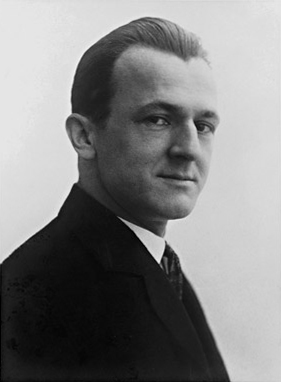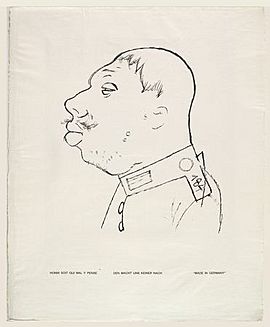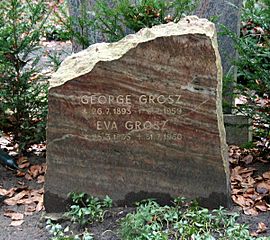George Grosz facts for kids
Quick facts for kids
George Grosz
|
|
|---|---|

George Grosz in 1921
|
|
| Born |
Georg Ehrenfried Groß
July 26, 1893 |
| Died | July 6, 1959 (aged 65) |
| Nationality | German, American (since 1938) |
| Education | Dresden Academy |
| Known for | Painting, drawing |
|
Notable work
|
The Funeral (Dedicated to Oscar Panizza) |
| Movement | Dada, Expressionism, New Objectivity |
George Grosz (born Georg Ehrenfried Groß; July 26, 1893 – July 6, 1959) was a famous German artist. He was known for his funny and often critical drawings and paintings of life in Berlin during the 1920s. He was a key member of art groups like Dada and New Objectivity during a time in Germany called the Weimar Republic. In 1933, he moved to the United States and became an American citizen in 1938. He changed his art style and subjects, showing his work often and teaching at the Art Students League of New York. He went back to Berlin in 1959 and passed away soon after.
Contents
Early Life and Art Training

George Grosz was born Georg Ehrenfried Groß in Berlin, Germany. He was the third child of a pub owner. His family was very religious. Grosz grew up in a town called Stolp (now Słupsk, Poland). After his father died in 1900, he moved to Berlin with his mother and sisters.
A cousin encouraged young George to take a weekly drawing class. He got better at drawing by carefully copying art by Eduard von Grützner. He also drew imaginary battle scenes. He was asked to leave school in 1908 because he was disobedient.
From 1909 to 1911, he studied at the Dresden Academy of Fine Arts. His first drawing was published in a funny magazine called Ulk in 1910. From 1912 to 1917, he studied at the Berlin College of Arts and Crafts. He started painting with oils in 1912.
In November 1914, Grosz joined the military. He hoped this would stop him from being sent to the front lines. He was discharged in 1915 after being in the hospital. In 1916, he changed his name to "George Grosz." He did this to make his name sound less German and more international. It was a way to protest against German nationalism. He also loved America because of books he read when he was young. His artist friend, Helmut Herzfeld, also changed his name to John Heartfield at the same time.
In January 1917, Grosz was called back to serve in the military. But in May, he was discharged again because he was not fit for service.
Art and Political Views
After the German Revolution of 1918–1919 in late 1918, Grosz joined a group called the Spartacist League. This group later became the Communist Party of Germany (KPD). He was arrested in January 1919 but escaped using fake papers. In 1920, he married Eva Peters.
In the same year, he published a book of his drawings called Gott mit uns ("God with us"). This book made fun of German society. Grosz was accused of insulting the army. He had to pay a fine and the printing plates for his book were taken away.
Travel to Russia
In 1922, Grosz traveled to Russia with a writer named Martin Andersen Nexø. They were briefly arrested as spies when they arrived. After their papers were checked, they could continue their trip. He met with several important leaders there, including Vladimir Lenin.
Grosz stayed in the Soviet Union for six months. He was not very impressed by what he saw. He left the Communist Party in 1923, but his political ideas did not change much.
Life in Germany Before Emigration
During the 1920s, some Nazi officers visited Grosz's art studio. He was wearing a worker's apron and pretended to be a handyman. This helped him avoid being taken away. His art was also part of the painting event at the 1928 Summer Olympics.
In 1928, he faced a legal case for publishing drawings that were against the church. One drawing showed prisoners being attacked by a minister. Another showed Christ being forced into military service. Grosz said he was not against religion or war, but he felt he needed to create these pictures. He was found not guilty after two appeals.
Moving to the United States
Grosz was strongly against the Nazis. He left Germany shortly before Adolf Hitler came to power. In June 1932, he was invited to teach at the Art Students League of New York. He returned to Germany in October 1932. But on January 12, 1933, he and his family moved to the United States. Grosz became an American citizen in 1938. He made his home in Bayside, New York.
In the 1930s, he taught at the Art Students League until 1955. One of his students was Romare Bearden, who was influenced by Grosz's art style. Another student was Robert Cenedella.
In America, Grosz decided to make a fresh start. He changed his art style and the things he painted. He continued to show his art regularly. In 1946, he published his life story, called A Little Yes and a Big No.
From 1947 to 1959, George Grosz lived in Huntington, New York. He taught painting at the Huntington Township Art League. It is said that he once used his famous painting, Eclipse of the Sun, to pay for a car repair. The painting was later bought by a house painter to settle a small debt.
In the 1950s, he opened a private art school at his home. He also worked as an Artist in Residence at the Des Moines Art Center. Grosz was chosen to be part of the National Academy of Design in 1950. In 1954, he was elected to the American Academy of Arts and Letters.
Later Life and Passing
On May 26, 1920, Grosz married Eva Louise Peter. They had two sons, Peter Michael Grosz (1926–2006) and Marty Grosz (born 1930), who became a jazz guitarist.
Grosz decided to move back to Berlin. He returned there in May 1959. He passed away on July 6, 1959.
Artistic Creations
Grosz made his first oil paintings in 1912 when he was still a student. His earliest known oil paintings are from 1916. By 1914, Grosz's art was influenced by Expressionism and Futurism. It also showed influences from popular drawings, graffiti, and children's art. His forms often had sharp outlines and looked see-through. The City (1916–17) was his first painting of a modern city scene. Other examples include Explosion (1917), Metropolis (1917), and The Funeral (1918). The Funeral shows a strange funeral parade. He settled in Berlin in 1918 and helped start the Berlin Dada art movement. He used his funny drawings to criticize people who supported the Weimar Republic.
His drawings were usually done with pen and ink. Sometimes he added watercolor. They often showed scenes of Berlin and the Weimar Republic in the 1920s. He was an excellent draftsman. However, his most famous works use a simple, exaggerated style of caricature. His art also includes some silly works, like Remember Uncle August the Unhappy Inventor, which has buttons sewn onto it.
After he moved to the USA in 1933, Grosz "strongly rejected his earlier work." He stopped doing caricatures. Instead of his earlier harsh city scenes, he painted many landscape watercolors. Stronger works, like Cain, or Hitler in Hell (1944), were rare. In his life story, he wrote that much of what was stuck inside him in Germany melted in America. He found his love for painting again. He said he carefully destroyed part of his past. While his style had started to soften in the late 1920s, Grosz's art in America became more gentle. This change is often seen as a decline in his work. His later art never became as famous as his art from his Berlin years.
In 1968, the Heckscher Museum of Art bought the painting Eclipse of the Sun for $15,000. They raised the money from public donations. This painting shows how arms manufacturers encourage war. Because of this, it became a place for people protesting the Vietnam War in the late 1960s and early 70s.
In 2006, the Heckscher Museum thought about selling Eclipse of the Sun. It was valued at about $19,000,000. They wanted to use the money for repairs to the building. But there was a big public outcry. So, the museum decided not to sell it. They announced plans to create a special place to display the painting in the renovated museum.
Influence and Legacy
Grosz's art influenced other New Objectivity artists. These included Heinrich Maria Davringhausen, Anton Räderscheidt, and Georg Scholz. In the United States, artists like Ben Shahn and William Gropper were influenced by his work.
In 1960, a short film about Grosz was nominated for an Oscar. He is also a character named "Fritz Falke" in a novel called A Princess in Berlin (1980). In the 2002 movie Max, actor Kevin McKidd played Grosz.
The Grosz family has been involved in legal discussions about his art. In 1995, the Grosz estate filed a lawsuit against an art dealer. They said the dealer had not paid them enough for hundreds of Grosz's works. This lawsuit was settled in 2006.
In 2003, the Grosz family started a legal discussion with the Museum of Modern Art in New York City. They asked for three paintings to be returned. Documents showed that the paintings were sold to the Nazis after Grosz left Germany in 1933. The museum did not settle the claim. They argued that the time limit for bringing such a claim had passed. It is known that the Nazis stole many paintings during World War II. Many families of German painters continue to try to get these works back from museums.
In 2015, Ralph Jentsch, who manages the Grosz estate, helped start a group in Berlin dedicated to the artist. In 2022, the Little Grosz Museum (Kleines Grosz Museum) opened in Berlin. It is in a former gas station that was turned into a living space. The museum is funded by private donations and also has a café and shop.
See also
 In Spanish: George Grosz para niños
In Spanish: George Grosz para niños
- Jedermann sein eigner Fussball, an artists' book by George Grosz and John Heartfield
- Assoziation revolutionärer bildender Künstler, an association of German artists
- List of German painters



